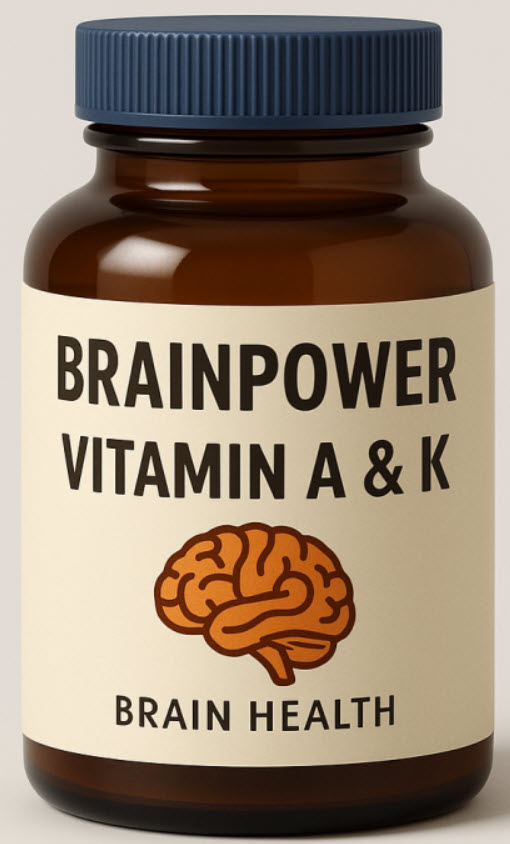
What the study actually did
• A Japanese team synthesized 12 “hybrid” vitamin-K molecules by grafting a retinoic-acid side chain onto vitamin K (MK-4). In cell studies, several of these analogues drove neural progenitors to become neurons at ~3× the potency of natural MK-4. In mice, lead compounds crossed the blood–brain barrier and boosted brain MK-4 levels. Shibaura Institute of Technology+1
Why people are talking about it
• Fox News and other outlets highlighted the “reversing brain damage” angle, but the primary sources frame these as candidate regenerative agents that now need animal efficacy and safety testing, then clinical trials. Fox News+2EurekAlert!+2
Bottom line for practice (for now)
• These are lab-made analogues, not off-the-shelf vitamins. They’re not ready for patient use. Retinoids can have real toxicities, and high-dose vitamin K can interact with anticoagulants—don’t extrapolate to supplementation. Watch for: (1) Alzheimer’s mouse-model efficacy (behavior + pathology), (2) toxicity/PK studies, and (3) phase-1 trials or trial registrations. Shibaura Institute of Technology
But here’s how you can use these vitamins to stay ahead of health problems. And we can evaluate your status for these important nutrients. Call 918-663-1111.
Vitamin A—especially in its active metabolite retinoic acid (RA)—plays a deep and multifaceted role in the health, repair, and function of neural tissue. Here’s a detailed breakdown:
1. Brain Development and Neural Differentiation
During embryonic development, retinoic acid acts as a morphogen—a signaling molecule that tells immature cells what type of neuron to become and where to go.
- It regulates neural stem cell differentiation, guiding stem cells into mature neurons, astrocytes, or oligodendrocytes.
- RA influences anterior–posterior patterning of the brain and spinal cord—essentially helping to “map out” the nervous system.
2. Synaptic Plasticity and Memory Formation
In the adult brain, vitamin A derivatives modulate genes involved in synaptic plasticity, which underlies learning and memory.
- Retinoic acid receptors (RAR and RXR) regulate the expression of synaptic proteins.
- Deficiency in vitamin A or retinoic acid signaling is linked to impaired long-term potentiation (LTP)—the mechanism neurons use to strengthen communication.
- Low RA levels have been correlated with cognitive decline in both animal models and human studies.
3. Neuroprotection and Anti-inflammatory Effects
Vitamin A helps stabilize and repair neural tissue through several mechanisms:
- Antioxidant properties: retinoids reduce oxidative stress that contributes to neurodegeneration.
- Anti-inflammatory modulation: they downregulate microglial overactivation, which is part of the destructive inflammatory response in Alzheimer’s and Parkinson’s.
- Promotion of myelin repair: retinoic acid can enhance oligodendrocyte differentiation, helping re-myelinate damaged axons.
4. Retinoic Acid and Neurogenesis
In the adult hippocampus—a region central to memory—retinoic acid stimulates the formation of new neurons (neurogenesis).
This is one reason researchers combine retinoic acid with other agents, such as vitamin K analogues, in regenerative experiments: it encourages both cell growth and proper differentiation.
5. Clinical Implications
- Deficiency: Chronic low vitamin A levels can lead to reduced cognitive performance and slower neural regeneration.
- Therapeutic interest: Controlled use of retinoic acid analogs is being studied in Alzheimer’s, spinal cord injury, and mood disorders because of its gene-regulating, neurotrophic, and synaptic effects.
In short, vitamin A (via retinoic acid) acts as a gene-level regulator for neuron formation, repair, and communication—essentially a molecular “architect” for the brain. It doesn’t merely protect nerve tissue; it helps build and rewire it.
1. Vitamin K₁ (Phylloquinone)
- Primary source: green vegetables such as kale, spinach, and broccoli.
- Main role: liver-based blood-clotting factors.
- Absorption: modest; fat in the meal helps.
- When preferred: if you’re just preventing deficiency or maintaining normal clotting—especially in people eating few greens.
2. Vitamin K₂ Family (Menaquinones)
Vitamin K₂ compounds have longer-chain side groups that change where they act and how long they stay in circulation.
MK-4 (Menaquinone-4)
- Source: animal foods (egg yolk, butter, liver, meat).
- Half-life: short (a few hours), but rapidly enters tissues like the brain, arteries, and pancreas.
- Functions: activates bone-building (osteocalcin) and anti-calcification (matrix Gla) proteins; also appears in neural tissue.
- Clinical data: Japanese studies using 45 mg/day MK-4 have shown reduced fracture risk in osteoporosis.
MK-7 (Menaquinone-7)
- Source: fermented foods (natto, some cheeses) or supplements.
- Half-life: very long (1–3 days), giving steady blood levels at low doses (90–200 µg/day).
- Functions: strong evidence for arterial elasticity and bone mineral density improvement.
- Practical edge: most cost-effective and convenient daily form.
3. Comparing Them
| Goal | Best-supported form | Typical dose range |
| General cardiovascular & bone health | K₂ (MK-7) | 90–200 µg/day |
| Osteoporosis therapy (clinical strength) | K₂ (MK-4) | 15–45 mg/day (used in Japan under supervision) |
| Basic clotting support | K₁ | met through vegetables |
4. Synergy
Vitamin K works closely with vitamin D₃ and vitamin A/retinoids—they coordinate calcium metabolism and gene regulation. Many practitioners pair MK-7 (or MK-4) with D₃ for better bone and vascular outcomes.
5. Cautions
- Anyone on warfarin or other anticoagulants must not add K supplements without a physician’s guidance; they directly affect INR.
- Very high pharmacologic doses (like the Japanese MK-4 protocol) should be monitored by a professional familiar with vitamin-K physiology.
Summary:
For most healthy adults, vitamin K₂ (MK-7) is the most practical and well-studied form for long-term cardiovascular and skeletal benefits. MK-4 may have additional tissue-specific and neurological advantages, but it requires higher, supervised dosing.

